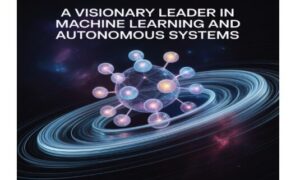In an era marked by rapid technological growth, autonomous systems stand as one of the most transformative innovations. The evolution of autonomous platforms has reshaped industries by integrating artificial intelligence, robotics, machine learning, and advanced sensor networks. Anusha Akkiraju‘s analysis highlights how these cutting-edge technologies are revolutionizing sectors such as transportation, healthcare, manufacturing, and agriculture, promising significant improvements in efficiency, safety, and sustainability.
The Rise of Autonomous Systems
Autonomous systems have become the cornerstone of the next generation of industrial automation. These systems leverage the power of artificial intelligence (AI) and machine learning algorithms to perform tasks with minimal human intervention. In transportation, autonomous vehicles use advanced perception systems that combine stereo vision cameras, radar, and ultrasonic sensors to navigate environments safely, even under adverse weather conditions. Additionally, autonomous mobile robots (AMRs) in manufacturing plants have helped reduce material handling time and improve safety, addressing critical challenges in logistics operations.
Transforming Decision-Making with AI
The decision-making processes within autonomous systems are powered by sophisticated AI models, particularly deep learning algorithms. These models are adept at processing multimodal data streams, enabling the systems to make informed decisions rapidly. Advanced reinforcement learning frameworks further enhance decision-making capabilities by employing a dual-level strategy high-level strategic planning paired with low-level tactical execution. These AI-driven systems not only optimize performance but also enhance safety by evaluating potential risks in real-time. Autonomous systems equipped with probabilistic risk assessment algorithms can predict hazards before they escalate.
Perception and Control: The Backbone of Autonomy
At the heart of autonomous systems lies a robust perception framework. Recent advancements in multi-modal sensor fusion especially through transformer-based architectures—have improved object detection accuracy in dynamic environments. One notable innovation is BEVFormer, a perception system that utilizes bird’s-eye-view data to understand the surroundings of autonomous vehicles, ensuring precise object tracking and scene interpretation.
Equally important are the actuation and control systems that allow autonomous systems to interact physically with their environment. These systems use neural networks and adaptive control algorithms to ensure stability.
Enhancing Connectivity and Data Sharing
Federated learning architectures have emerged as a solution to ensure secure and efficient communication between autonomous systems. These frameworks allow systems to collaborate in real-time, sharing insights and updates across a network of devices. In healthcare, AI-driven decision support systems process data from various sources to optimize treatment plans and diagnostics, demonstrating the critical role of communication in enhancing the performance and reach of autonomous systems.
Industry-Specific Innovations and Applications
The impact of autonomous systems extends across multiple industries. In healthcare, robotic surgery platforms and AI-based patient monitoring systems are significantly improving surgical precision, reducing recovery times, and enhancing patient care. In manufacturing, smart factories leveraging digital twin technology and collaborative robots are streamlining production processes.
In agriculture, smart farming technologies such as autonomous tractors equipped with GPS guidance and machine learning algorithms are revolutionizing the way crops are managed, resulting in improved yield prediction and better water efficiency. These applications highlight the immense potential of autonomous systems.
Challenges and Future Directions
Despite rapid advancements, several challenges remain in the development of autonomous systems. Issues related to safety, resource optimization, and ethical concerns need to be addressed to ensure the reliable and responsible deployment of these technologies. Safety engineering, particularly in robotics, is essential to ensure that systems operate reliably in diverse and unpredictable environments.
The future of autonomous systems will likely see continued improvements in cognitive architectures, focusing on making systems more adaptable and capable of learning from their experiences. This would enable them to handle a broader range of tasks, reducing the need for human intervention and enhancing efficiency across industries.
In conclusion, autonomous systems continue to evolve, they hold the potential to redefine industries and reshape our daily lives. From enhanced decision-making in complex environments to transforming how industries operate, these technologies are paving the way for smarter, more efficient systems. However, as we embrace these innovations, it is crucial to strike a balance between technological progress and ethical responsibility. As Anusha Akkiraju‘s study highlights , the future of autonomous systems is bright, but it will require continued collaboration and safety measures to ensure they benefit society.



































